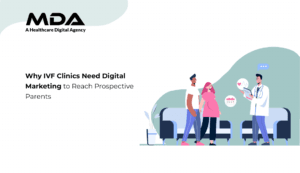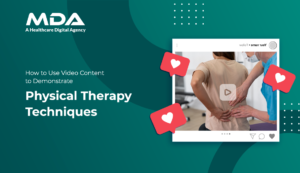In today’s fast-paced healthcare world, branding has become a huge deal for hospitals and doctors. There is much more to it than logos. It now influences how patients perceive healthcare systems and organizations. With patients having more choices than ever, effective branding is now a necessity, not an option.
The Significance of Branding for Hospitals and Doctors
Branding is the art of creating a unique identity in the eyes of customers. In healthcare, it plays a vital role in improving service quality and understanding patient needs. In order to keep up with the competition, hospitals and doctors must adopt effective branding strategies.
There was no need for hospitals to prioritize branding in healthcare in the past as there was little competition. Patients had fewer choices based on insurance and workplaces. But times have changed, and hospitals now face various challenges and opportunities to establish a strong presence in patients’ minds.
The Importance of Digital Marketing in Hospital and Doctor Branding
One powerful tool that is revolutionizing branding in healthcare in the digital era is digital marketing. It opens up a world of opportunities to reach a broader audience, improve patient engagement, and build brand awareness.
Digital marketing empowers hospitals and doctors to create informative and valuable content. Through blog posts, articles, and videos, they can educate patients about health concerns, medical procedures, and healthy lifestyles. By getting the patients to recognize them as reliable sources, they earn the trust and loyalty of the patients.
With the help of social media platforms, you can have direct interactions with patients, fostering meaningful conversations and answering questions directly from them. Visuals and stories humanize the brand, creating a sense of community and driving word-of-mouth referrals.
A well-optimized website will be able to attract more visitors and potential patients to your website by increasing its visibility on search engines. Email marketing maintains connections with existing patients and reaches out to potential ones, all while respecting their privacy and complying with data protection laws.
With digital advertising, it is possible to reach the right audience with tailored messages that are customized according to their needs. Online campaigns drive traffic to websites, boosting brand recognition.
Incorporating telemedicine with virtual consultations displays a patient-centric approach, making healthcare more accessible and convenient for patients across the globe.
Overall, digital marketing is a game-changer in hospital and doctor branding. A healthcare institution can thrive in the digital age if they take advantage of its power, provide exceptional patient experiences, and make an impact on their audiences.
The Key to Successful Hospital Branding
It takes more than a logo or tagline to make your hospital stand out in an intensely competitive industry like healthcare. An in-depth research, strategic planning, and thoughtful execution are all needed.
Here are some essential strategies for building a successful hospital brand:
Brand Research: Understanding the Competition
Successful hospital branding relies on thorough brand research. It lays the foundation on which the entire branding strategy is built. To stand out in the market, hospitals must gain a clear understanding of their competition, target audience, and industry trends. By conducting comprehensive research, hospitals can identify their unique selling points, analyze competitors’ strengths and weaknesses, and discover opportunities for differentiation.
Research involves studying patient preferences, behaviors, and expectations. Surveys, focus groups, and data analysis help gain valuable insights into what patients value most about healthcare providers. This knowledge allows hospitals to tailor their branding efforts to meet patients’ expectations more efficiently.
Brand Positioning: Engaging Patients Effectively
In branding, you want to make sure your hospital has a distinct and memorable brand identity in the patients’ mind. It involves influencing how people feel about and perceive the brand. To achieve effective brand positioning, hospitals must identify their unique selling points or USPs and align them with patient needs.
A successful brand positioning strategy highlights the hospital’s core values, mission, and commitment to patient care. Emphasizing qualities such as empathy, compassion, and trust builds a strong bond with patients. When patients feel understood and cared for, they are more likely to choose your hospital over competitors.
Brand Identity: Crafting a Consistent Message
An organization’s brand identity includes the visual aspects representing the organization (or in this case, the hospital), including logos, colors, fonts, and design elements. Through a solid brand identity, a hospital is able to communicate its personality consistently across all touchpoints.
The logo serves as a visual representation of the hospital’s identity and should be easily recognizable and memorable. Colors play a significant role in stimulating emotions and associations; hospitals often choose calming and reassuring colors to create a sense of comfort for patients.
Fonts and design elements contribute to the overall aesthetic of the brand. A clean and professional design creates a sense of reliability and competence. An organization’s reputation is strengthened when its brand identity is consistent across marketing materials, signage, and online platforms.
Brand Story Experience and Activation: Building Trust and Reputation
A compelling brand story is a powerful tool for connecting with patients on a deeper level. Sharing authentic patient experiences and emotional stories can evoke empathy and trust. Testimonials from patients who have had positive outcomes or heartwarming experiences can strengthen the hospital’s reputation and create a sense of community.
By delivering the brand story consistently throughout all channels, such as social media and websites, the hospital’s image and values are reinforced. Storytelling is also a great way for hospitals to showcase their commitment to medical excellence, cutting-edge technology, and advancements in healthcare.
Wayfinding Signage: Enhancing the Patient Experience
The moment patients step into a hospital, their experience begins. Creating a warm and welcoming environment is essential in establishing a positive patient experience. Wayfinding signage plays a crucial role in guiding patients through the hospital’s facilities and enhancing their overall experience.
Well-designed and clear signage helps patients navigate the hospital with ease, reducing anxiety and stress. It should be strategically placed in high-traffic areas, such as entrances, waiting rooms, and hallways. The use of easy-to-follow symbols and graphics can further help patients in finding their way.
In addition to practical wayfinding, hospitals can incorporate branding elements into the signage to reinforce the hospital’s identity. This can be achieved through the use of consistent colors, logos, and fonts.
By implementing these key strategies, hospitals can elevate their brand presence, foster patient trust, and gain a competitive advantage in the healthcare industry.
The Impact of Branding on Hospitals and Doctors
Traditionally, hospitals were viewed as places solely dedicated to caregiving, where branding was overlooked. However, as healthcare has evolved, the importance of branding has become evident. Branding goes beyond a logo; it significantly affects the success and reputation of hospitals and doctors.
Let’s talk about how branding impacts the healthcare industry, extending beyond hospitals.
Elevating Recognition and Trust
A good brand builds trust among patients and elevates recognition. Hospitals and doctors stand out in a crowded healthcare market if they have a clear brand identity. A visually appealing logo, thoughtful colors, and a consistent style leave a lasting impression on patients.
A familiar and trusted brand makes patients feel more confident and gives them some peace of mind. Trust is very important in the patient-provider relationship, and branding plays a big role in nurturing and strengthening it.
Ensuring Internal Consistency
Branding goes beyond external appearance; it reflects values, mission, and culture. A successful brand strategy aligns internal elements with the external identity, creating a consistent experience for patients, doctors, and staff.
When a hospital or doctor is able to maintain internal consistency, their reputation as a reliable facility or doctor will grow. The more aligned the brand’s promises with the patient’s experience, the more satisfied and loyal the patient becomes. Stronger brand reputations are built by engaged employees who connect with the brand and offer better care to their patients.
Contributing to Increased Revenue
Hospitals and doctors should not underestimate the impact of branding on their revenue. A strong brand that resonates with patients can attract a larger clientele.
Having a brand name that patients recognize and trust drives referrals and recommendations. Satisfied patients gladly refer the hospital or doctor to others. Moreover, a brand that has a strong reputation can be able to command a higher price in the market, since it is competing on value rather than just on price in the marketplace. Patients are always willing to pay more for healthcare services from a trusted and renowned brand.
The Wider Significance of Healthcare Branding
Branding is often associated with hospitals, however, it is important to keep in mind that branding affects the entire healthcare industry as a whole. Organizations cannot afford to ignore branding in healthcare in today’s highly competitive landscape.
Patients’ expectations and choices have been revolutionized by digital healthcare brands and direct-to-consumer healthcare services. There are more healthcare providers now than ever before and patients have access to better information.
In this environment, branding is a vital strategy for companies trying to distinguish themselves from their competitors and establish unique positions in the market. Not only patients, but also doctors, nurses, insurance providers, and other stakeholders are influenced by effective healthcare branding.
The Benefits of Effective Healthcare Branding
Branding plays a very important role in today’s fast-paced and competitive healthcare industry, and for ensuring effectiveness. When healthcare organizations put effort into researching and planning their branding strategies, numerous benefits can be achieved.
Let’s take a look at some of the benefits of effective healthcare branding:
Understanding Patient Needs:
The healthcare landscape is always changing due to the ever-evolving nature of technology, the changing demographics, and the evolving demands of patients. To stay ahead, healthcare organizations must be aware of these changes and adapt their services accordingly.
Effective healthcare branding involves gaining deep insights into patient behavior, expectations, and preferences. Through one-on-one interviews and patient-wide surveys, organizations can understand what patients truly desire and need. When equipped with this knowledge, healthcare brands can customize their efforts in order to meet patient demands, build strong relationships, and earn patient loyalty.
Establishing Trust
Trust is an absolute necessity in the healthcare industry, as patients entrust their lives and well-being to healthcare providers. Effective branding plays a crucial role in building and reinforcing this trust. By presenting a consistent brand identity and messaging, healthcare organizations can convey professionalism, competence, and compassion.
A well-designed logo, thoughtful color palette, and consistent visuals can have a positive effect on patients, evoking positive emotions and gaining their confidence. This trust-building process should extend across all patient touchpoints, from websites to in-person interactions with medical staff. When patients have confidence in the brand, they are more likely to seek care from that organization again.
Standing Out in the Competition
The healthcare industry is incredibly competitive, with many providers competing for patients’ attention. In order to stand out in the healthcare industry and to differentiate yourself from your competitors, it is crucial to have an effective branding strategy. Brand research helps identify patient needs and assess the strengths and weaknesses of competitors.
By using this knowledge, your healthcare organization can identify opportunities for differentiation and use branding to take advantage of them. By showcasing your strengths, such as specialized services, patient-focused care, or advanced technology, you can establish yourself as a leader and connect with patients on an emotional level through compelling storytelling and brand positioning.
Improving the Patient Journey
In the modern healthcare landscape, the patient experience is an essential component. Effective branding plays a crucial role in shaping the entire patient journey, starting with the first moment of awareness and continuing through the completion of the treatment and beyond. During the awareness stage, branding efforts should capture patients’ attention and create a lasting impression. A well-designed website, informative content, and engaging social media presence can build patient interest and trust.
As patients move on to the decision-making stage of the process, effective branding ensures a seamless and positive experience. Clear and intuitive wayfinding signage in hospitals reduces patient anxiety and confusion, while consistent branding across all physical and digital touchpoints reinforces the organization’s values and reliability. Throughout the treatment phase, healthcare organizations can use branding to build stronger patient-provider relationships through personalized interactions, compassionate care, and transparent communication.
Even after treatment, effective branding remains valuable for nurturing long-term patient relationships through relevant follow-up communication, email newsletters, and patient testimonials, which support the organization’s commitment to patient well-being.
Crafting a Standout Healthcare Brand
Embrace Innovative Technology:
Incorporate innovative technology to enhance the patient experience and differentiate your brand. Use telemedicine services, mobile apps, or online platforms to provide convenience and accessibility to patients. By incorporating advanced technology you not only set your brand apart but also position your organization as forward-thinking and modern in the eyes of patients.
Engage with the Community:
Build a strong presence within your local community to foster brand awareness and loyalty. Participate in health fairs, sponsor community events, or host educational workshops to connect with potential patients. Making sure that your commitment to community health and well-being is visible, strengthens your brand’s reputation and builds trust with patients.
Promote Thought Leadership:
Establish your organization as a thought leader in the healthcare industry by sharing valuable insights and expertise. Publish informative articles, blogs, or whitepapers that address relevant healthcare topics. Being recognized as an authority in your field helps position your brand as a reliable source of information and attracts patients seeking high-quality care.
Solicit and Showcase Patient Testimonials:
Encourage satisfied patients to share their positive experiences and outcomes. Display patient testimonials on your website and social media platforms to showcase the real impact of your healthcare services. Genuine testimonials serve as powerful endorsements and help potential patients feel confident in choosing your brand for their healthcare needs.
Conclusion
Digital marketing is a game-changer for doctor and hospital branding in today’s digital era. It offers a wealth of opportunities to reach a wider audience, engage patients effectively, and enhance brand awareness. Through informative content, social media interactions, optimized websites, targeted advertising, and telemedicine services, healthcare organizations can build a strong brand presence and connect with patients on a deeper level.
Patient loyalty and trust are fostered, and they’re more likely to pick a reliable and compassionate healthcare provider. Building standout healthcare brands requires innovative technology, community involvement, and thought leadership. To succeed and thrive in this competitive landscape, hospitals and doctors need effective digital marketing strategies and we at MDA are here to provide you with all you need.
By embracing effective branding strategies, healthcare organizations can differentiate themselves, build patient trust, and thrive in the competitive market. Key elements like strategic positioning, cohesive visual identity, compelling storytelling, and a patient-centric approach play pivotal roles in establishing a unique brand identity. Engaging patient experiences, embracing technology, community involvement, and thought leadership further enhance your healthcare brand’s impact. Creating an exceptional healthcare brand not only builds patient loyalty but also positions the organization as a reliable and compassionate healthcare provider in the ever-evolving healthcare landscape.
FAQs
1. In the healthcare industry, how can branding be helpful for hospitals and doctors to gain recognition?
Ans: It is crucial for hospitals and doctors in the healthcare industry to brand themselves so that they can establish a unique identity and influence the way patients perceive their providers. Creating a brand that stands out allows healthcare organizations to gain patient trust, attract more patients, and gain a competitive advantage in today’s dynamic market.
2. What are the best ways to conduct brand research to build a successful brand for hospitals and doctors?
Ans: Brand research can be done by hospitals and doctors to gain a clear understanding of their competitors, their target audience, and the current trends in the healthcare industry. Using surveys, focus groups, and data analysis, we are able to discover the preferences, behaviors, and expectations of patients. It is therefore possible to tailor the branding efforts of your healthcare organization according to the needs of your patients.
3. When it comes to hospital branding, what role does brand positioning play?
Ans: When it comes to hospital branding, the brand positioning is crucial as it helps create a distinct and memorable image of the hospital in the minds of the patients as well as the staff. You will be able to highlight your core values, mission, and commitment to patient care by aligning your unique selling points with patient needs. Patients will be more likely to choose your hospital over the competitors as a result of developing a strong bond with them.
4. Can hospitals create an identity that is consistent with their brand?
Ans: Yes! With the help of visual elements such as logos, colors, fonts, and design elements, hospitals can establish a consistent brand identity. The hospital’s logo serves as a graphic representation of the hospital’s identity and is easily recognizable among the public. It is important to select colors that evoke positive emotions and create a sense of comfort among your patients. A professional and reliable brand image should be maintained across marketing materials and online platforms by using consistent fonts and design elements.
5. Is storytelling a useful tool for hospitals to build trust and reputation?
Ans: Using storytelling as a tool is one of the most effective ways hospitals can connect with their patients on a deeper level and build trust with them. Hospitals can demonstrate their commitment to quality medical care and patient care by sharing genuine patient experiences and emotional stories through the sharing of authentic patient experiences and emotional stories. It is important that these stories are consistently shared throughout various channels in order to reinforce the hospital’s image and values, resulting in a stronger reputation as well as a sense of community.
6. What are the ways in which wayfinding signage contributes to the patient experience?
Ans: There is a crucial role that wayfinding signage plays in helping patients to navigate through a hospital’s facilities and enhancing their experience in general. A well-designed and clear signage helps reduce anxiety and stress among patients by helping them find their way around the hospital area. The incorporation of branding elements into the signage not only helps reinforce the hospital’s identity, but it also creates an environment that is welcoming and warm for the patients.
7. What are the effects of branding on hospitals and doctors that go beyond trust and recognition?
Ans: The concept of branding extends beyond recognition and trust; it extends to internal consistency as well as an increase in revenues. In order to enhance the hospital’s reputation and improve patient satisfaction, it is essential to establish a brand with strong values and consistent experiences for patients. Moreover, a strong brand can lead to the development of new patient referrals, as well as a stronger position in the competitive market if it emphasizes value over price.
8. Besides hospitals, why is branding such an important part of the entire healthcare industry?
Ans: As a result of increased competition and patient choice, branding is becoming more and more important for all sectors of the healthcare industry. Health care organizations now have to differentiate themselves and establish a unique position in the market as direct-to-consumer services and digital brands take off. A brand’s ability to communicate effectively determines how patients, doctors, insurance companies, and other stakeholders view the organization.
9. How can healthcare organizations benefit from effective healthcare branding?
Ans: In addition to identifying changing patient needs through research, building trust among patients, and differentiating from competitors, effective healthcare branding also enhances the patient journey. A healthcare organization can fine-tune its services to meet the preferences and needs of its patients by understanding their preferences and needs.
10. In order to create a brand that stands out from the competition, what strategies should healthcare organizations consider?
Ans: Healthcare organizations can focus on strengthening their brand positioning by striving to strengthen their brand positioning, refreshing their brand identity, enhancing the patient experience and leveraging compelling storytelling.
It is possible for them to craft standout brands that resonate with patients and succeed in a competitive environment by defining their unique value propositions, aligning their visual identity with their brand promise, sharing inspiring stories, and providing a consistent patient experience.

Meet Nandini Pathak, our tech-savvy content writer who adores dogs. With SEO proficiency, she crafts engaging content in the world of technology. Her curiosity drives her passion for learning and growth. Whether she’s writing about the latest trends or simplifying complex ideas, Nandini’s love of technology is clear. Her words not only inform but also resonate. With every piece she creates, she blends her expertise and enthusiasm, making technology accessible and exciting for all.







